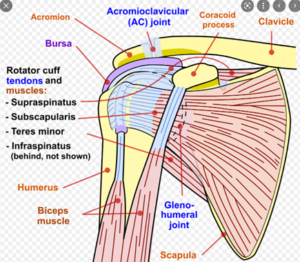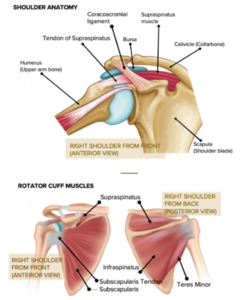Yesterday we were speaking with our favorite orthopedic surgeon, Dr. Kate Connors, about how difficult it is to evaluate shoulder injuries. It’s easy to say “rotator cuff tear” but what does that mean and more important to us, what is it worth. Below is a medical illustration of the shoulder followed by our review of shoulder injury cases. In the event you don’t like this illustration, scroll to the last page for another one.

CHRISTOPHER SWIFT V. ALEXANDER YANOS (152729/16)
DECIDED: 2020
VENUE: Supreme New York
TYPE OF CASE: Automobile Liability
FACTS: A 50 year old man was in the back seat of a car stopped near an intersection when it was struck in the rear.
INJURIES:
- As a result of the impact, the plaintiff claimed to be propelled forward, resulting in his left, nondominant arm’s shoulder hitting the back of the passenger’s front seat.
- The plaintiff claimed a tear of his left shoulder’s rotator cuff and glenoid labrum.
- The plaintiff suffered trauma in his left elbow what has led to the inflammatory conditions of bursitis (inflammation of the small, fluid filled sacs that cushion your bones, tendons, and muscles) and epicondylitis (also known as tennis elbow).
- The plaintiff received 5 months of physical therapy, then ceased treatment for 6 months, and then resumed for approximately 8 weeks.
- He underwent administration of two injections of corticosteroids.
- Although arthroscopic surgery has been recommended for his left shoulder, the plaintiff has refused the procedure.
- The plaintiff claims that his left elbow and shoulder remain painful. He claims that this pain has hindered his ability to write and type, which is problematic because he is a professor. He also claims that the pain has hindered his ability to ride a bike.
- Defense argued that the plaintiff did not suffer a serious injury as defined by the no fault law, Insurance Law §5102(d). Defense counsel argued that the accident was a minor collision and therefore could not have caused the injuries for which the plaintiff was seeking damages.
- Defense pointed out that in the year preceding the accident, the plaintiff received anti-inflammatory medication injections in his left shoulder.
- The expert orthopedist for the defense opined that swift only suffered a strain of his left shoulder and that he failed to show objective evidence of disability of the left shoulder or elbow.
- The expert neurologist for the defense reported that the plaintiff showed no objective evidence of neurological disability.
VERDICT: The parties negotiated a $100,000/$20,000. The jury found the defendant liable and that the plaintiff suffered a serious injury. They awarded a total of $57,500
KNOCH V. CITY OF NEW YORK (43944/07)
AFFIRMED: March 16, 2016, Appellate Division, Second Department
VENUE: Supreme Kings
TYPE OF CASE: Trip and Fall
FACTS: A 59-year-old woman was about to cross the street when she tripped over the sidewalk, falling into the street. The plaintiff claimed that the sidewalk was defective.
INJURIES:
- The plaintiff sought treatment immediately after the accident. At the hospital, she was given a sling and pain killers.
- The plaintiff suffered from a displaced fracture of the greater tuberosity of the humerus (the prominent area of bone at the top of the humerus, attached to the rotator cuff muscles) of the plaintiff’s left, dominant arm.
- The plaintiff also experienced a partial rotator cuff tear and potential labral tear.
- The treating orthopedic surgeon recommended surgery and physical therapy.
- She received physical therapy for seven months, then switched to home exercises.
- The plaintiff suffers from post-traumatic adhesive capsulitis (frozen shoulder), resulting in limited range of motion and daily, continuous pain.
- The plaintiff claims that her shoulder condition makes it difficult to get dressed without assistance. She testified that she is now unable to lift her grandchildren, iron, or take part in recreational activities.
- The plaintiff returned to work one month after the accident.
- The defense claimed that the plaintiff should not be awarded future damages because the plaintiff failed to mitigate her own damages by ceasing physical therapy and forgoing the physician recommended surgery. The plaintiff claims that she continues her physical therapy exercises in her home and was unable to afford the surgery as her workers compensation claim was denied.
- The defendant’s examining orthopedic surgeon opined that the plaintiff’s fracture healed well, she did not sustain a rotator cuff tear, and that she did not need surgery.
- The plaintiff’s expert opined that the plaintiff had a permanent 75% loss of use of her shoulder.
AFFIRMATION: The jury awarded $150,000 for the past 4.5 years and $50,000 for the future 20 years of pain and suffering. The Appellate Division, Second Department affirmed the trial court’s decision. According to the US Bureau of Labor Statistics, $200,000 in 2016 would be $230,940.08 in 2021.
MOLINA V. NEW YORK CITY TRANSIT AUTHORITY (11858 303734/09)
REDUCED: March 4, 2014, Appellate Division, First Department
VENUE: Supreme Bronx
TYPE OF CASE: Slip and Fall
FACTS: A 47-year-old building engineer was walking down the stairs of the subway station when he slipped on a plastic bag. The jury found the defendant liable for the injury as the employees knew that there was regularly debris on the stairs, but they failed to take additional measures to clean the area.
INJURIES:
- Immediately following the accident, the plaintiff was treated at the hospital with pain medication and a sling for his arm.
- The plaintiff claimed to suffer tears of his rotator cuff and labrum in his right shoulder, which in turn caused a rotator cuff tear of the supraspinatus tendon in his left shoulder due to overuse.
- The plaintiff suffered from a herniated disc at L5-S1.
- The plaintiff received physical therapy two and eventually three times a week for eight weeks.
- Six months after the accident, the plaintiff underwent arthroscopic surgery on his right shoulder to repair the tears.
- For the four months following the surgery, the plaintiff’s shoulder was immobilized in a sling.
- Eleven months after the accident, the plaintiff underwent arthroscopic surgery on his left shoulder to debride the tissue.
- The plaintiff suffered significant and permanent range of motion in both shoulders.
- The plaintiff received two epidural steroid injections for his herniated disc and will likely require future surgery.
- The defense argued that the plaintiff’s injuries were not nearly as extensive as he claimed. Counsel claimed that the plaintiff had preexisting arthritis and impingement of his right shoulder and preexisting degenerative changes in his lower back.
- The plaintiff’s counsel concede that the plaintiff had some preexisting conditions before the accident, however they were never so severe to require treatment.
REDUCTION: The jury awarded the plaintiff $600,000 for the past 3 years and $1,300,000 for the future 27 years of pain and suffering. The Appellate Division, First Department affirmed the jury’s award for past pain and suffering but reduced the award for future pain and suffering to $800,000. According to the Bureau of Labor Statistics, $1,400,000 in 2014 is equivalent to $1,637,313.39 in 2021.
PETERSON V. MTA (9331/12)
REDUCED: November 8, 2017, Appellate Division, Second Department
VENUE: Supreme Kings
TYPE OF CASE: Automobile Liability
FACTS: A 67-year-old woman was sitting on the bus when it made a sharp turn, causing her half gallon bottle of milk to slide across the floor. When the bus came to a stop, the woman tried to retrieve her milk, but the bus made a sudden jerk, causing her to be thrown to the ground.
INJURIES:
- Immediately after the accident, the plaintiff complained of head, neck, and shoulder pain. She was treated at the hospital, prescribed pain medication, and released.
- The plaintiff began chiropractic treatment four days after the accident, which she continued for one year.
- An MRI taken four months after the accident revealed that she had a torn rotator cuff and labrum in her left shoulder.
- The plaintiff underwent arthroscopic surgery on her left shoulder, followed by a year of physical therapy.
- Two years after the first surgery, an MRI of the right shoulder revealed a torn rotator cuff (from overuse) and supraspinatus muscle and fusion in the subacromial space.
- The plaintiff underwent arthroscopic surgery on her right shoulder, followed by seven months of physical therapy.
- The plaintiff claims to suffer from permanent significant range of motion deficits in both shoulders.
- The plaintiff claims to suffer from continued intense pain which at times radiates down her arms, spasms and limitations in both shoulders.
- The plaintiff claims that she is unable to carry groceries, cook, clean the house, play with grandchildren, travel, or jog.
- The plaintiff claims to suffer from intense lower back pain which prevent her from sitting for long periods of time.
- The plaintiff’s treating orthopedic surgeon testified that the plaintiff should not expect any further improvement or deterioration in either shoulder.
- The defense’s expert opined that her left shoulder surgery was successful, and she should only suffer from minor range of motion deficits.
REDUCTION: The jury awarded $800,000 for the past 3.5 years and $1,500,000 for the future 17 years of pain and suffering. The Appellate Division, Second Department reduced the award for future pain and suffering to $800,000. According to the Bureau of Labor Statistics, $1,600,000 in 2017 is equivalent to $1,802,458.42 in 2021.
SCHWARTZ V. DREYER (5934/2005)
DECIDED: March 31, 2011
VENUE: Supreme Nassau
TYPE OF CASE: Automobile Liability
FACTS: The plaintiff rear-ended the defendant. When the plaintiff stopped and exited his car, the defendant intentionally drove his car into the plaintiff, yelled at him, and fled the scene of the accident.
INJURIES:
- The plaintiff suffered from impingement syndrome in his right shoulder (joint arthritis causing inflammation and pain around the rotator cuff).
- The plaintiff suffered injury to his cervical spine.
- The plaintiff was in a car accident in 2002 which left him with pain in his right shoulder’s AC joint, cervical spine, and thoracic spine.
- The plaintiff underwent an arthroscopic acromioplasty and resection on his right shoulder.
- The treating physician testified that after six weeks of physical therapy, the plaintiff had full range of motion in his shoulder but still suffered from “crepitus” or creaking and subjective complaints of pain.
- After surgery, the plaintiff continued to visit the physician for pain management for his spine and shoulder.
- The plaintiff returned to work 10 days after the accident, though he testified that he worked with pain
- The plaintiff claimed to suffer two types of serious injuries under the Insurance Law: permanent consequential limitation of use of a body organ or member and significant limitation of use of a body function or system. Since the courts did not hear testimony from treating physicians on these charges, both were declined.
- The defense counsel argued that there were only subjective complaints of pain, not objectively verified by the treating physician.
VERDICT: The jury awarded $50,000 for past and nothing for future pain and suffering. According to the U.S. Bureau of Labor and Statistics, $50,000 in 2011 is equivalent to $62,111.36 in 2021.
If you wanted to see another illustration, here you go.







